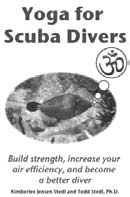Downward Dogs Can Improve Your DivingContents of this Issue: Pirates Point Resort, Little Cayman How Useful Is a Dye Marker in a Search? Downward Dogs Can Improve Your Diving Bahamas, B.V.I., Ontario, Roatan… Rebreathers, Pack Your Canisters Properly When There’s Not Enough Divers The Underwater “Spin Cycle” Known as Diver’s Vertigo Dive-Related Death Investigations Drinking and Diving: How Much Alcohol Is Too Much? Even You Could Learn from These Kids’ Dive Books How Divers Will Never Be Lost Again So How Are the Oceans Really Doing? Fiji Divers Caught in Pricing Battle at Garden Island Resort For Your Favorite Buddy . . . give the gift of Undercurrent Editorial Office: Ben Davison Publisher and Editor Undercurrent 3020 Bridgeway, Suite 102 Sausalito, CA 94965 from the October, 2008 issue of Undercurrent
Can a yoga course really help reduce air consumption, improve flexibility and buoyancy control, and make a more proficient diver – in just one week? Charlotte Boan, a writer for the British magazine DIVE, checked out these claims from a “scuba Zen” course offered by Sunra Yoga in the Red Sea resort town of Dahab, Egypt. “The fusion of yoga and scuba was a concept that perplexed me,” writes Boan. “I had visions of fins wrapped around my head, mid-water locust positions and other bizarre underwater contortions.” But later she found that there would be no underwater gymnastics. The daily schedule was a 90-minute Hatha-style (exercise-focused) yoga session in the morning, followed by a day of shore diving. Yoga-practicing divers say there is a connection to the relaxed feeling one gets from both diving and yoga. As well as the physical benefit of muscle-stretching postures, yoga offers an effective way to switch off, focus on the present and relax, similar to finning underwater.
“When I first started yoga, I saw the impact on my buoyancy control,” says Todd Stendl, who, along with his wife Kimberlee, wrote the recent book Yoga for Scuba Divers. “Holding yoga poses for extended periods is helpful in strengthening core muscles, allowing divers to maneuver easily instead of flailing around.” After doing yoga poses, breath-holds, and timed inhalations and exhalations, Boan says she felt immediate improvement in her diving. “The morning stretching techniques helped ease my muscles, minimize fatigue, made me more alert and gave me more energy. The breathing and relaxation techniques had a dramatic impact on my air consumption, giving me at least a third more air supply on each dive.” Yoga can be done anywhere there’s space to unroll a yoga mat. In their book, the Stendls describe and photograph the yoga poses best for divers, and explain why they’re beneficial. For example, the Downward Facing Dog is an excellent calf stretch for divers to improve their finning underwater. The Navasana, or boat, is tougher but is great for strengthening the abdominal muscles and hip flexors. The book also gives details for breathing exercises, and visualization techniques to prepare for tough dives. Newman offers three-day courses at Playa Del Carmen (www.morethanyoga.com). Janine Davis, maker of a divers’ brew of tea called Diversitea, hosted a yoga and meditation dive week at Habitat Curacao last spring and says the trip was sold out (contact her at www.diversitea.com about future trips). The Stendls plan to host their own yoga-focused dive trip next March at Dominica’s Jungle Bay eco-resort; visit www.8thElementDiving.com for details. Buy their book Yoga for Scuba Divers at our Web site (Undercurrent) - - you’ll get it at the best price Amazon.com has to offer, and all proceeds go to save the reefs. |

I want to get all the stories! Tell me how I can become an Undercurrent Online Member and get online access to all the articles of Undercurrent as well as thousands of first hand reports on dive operations world-wide
| Home | Online Members Area | My Account |
Login
|
Join
|
| Travel Index |
Dive Resort & Liveaboard Reviews
|
Featured Reports
|
Recent
Issues
|
Back Issues
|
|
Dive Gear
Index
|
Health/Safety Index
|
Environment & Misc.
Index
|
Seasonal Planner
|
Blogs
|
Free Articles
|
Book Picks
|
News
|
|
Special Offers
|
RSS
|
FAQ
|
About Us
|
Contact Us
|
Links
|
3020 Bridgeway, Ste 102, Sausalito, Ca 94965
All rights reserved.

 “Yoga is great for
divers because it offers
breathing exercises that
strengthen the lungs,
slow the heart and
allow greater control of
the breathing reflex,”
says Arielle Thomas
Newman, a yoga
instructor who holds
“Yoga by the Sea”
courses through Sea
Life Divers in Playa
Del Carmen, Mexico.
Also, “divers tend to
have upper-back tension
because of the tanks they’re carrying, and yoga stretches can help that as
well.”
“Yoga is great for
divers because it offers
breathing exercises that
strengthen the lungs,
slow the heart and
allow greater control of
the breathing reflex,”
says Arielle Thomas
Newman, a yoga
instructor who holds
“Yoga by the Sea”
courses through Sea
Life Divers in Playa
Del Carmen, Mexico.
Also, “divers tend to
have upper-back tension
because of the tanks they’re carrying, and yoga stretches can help that as
well.”